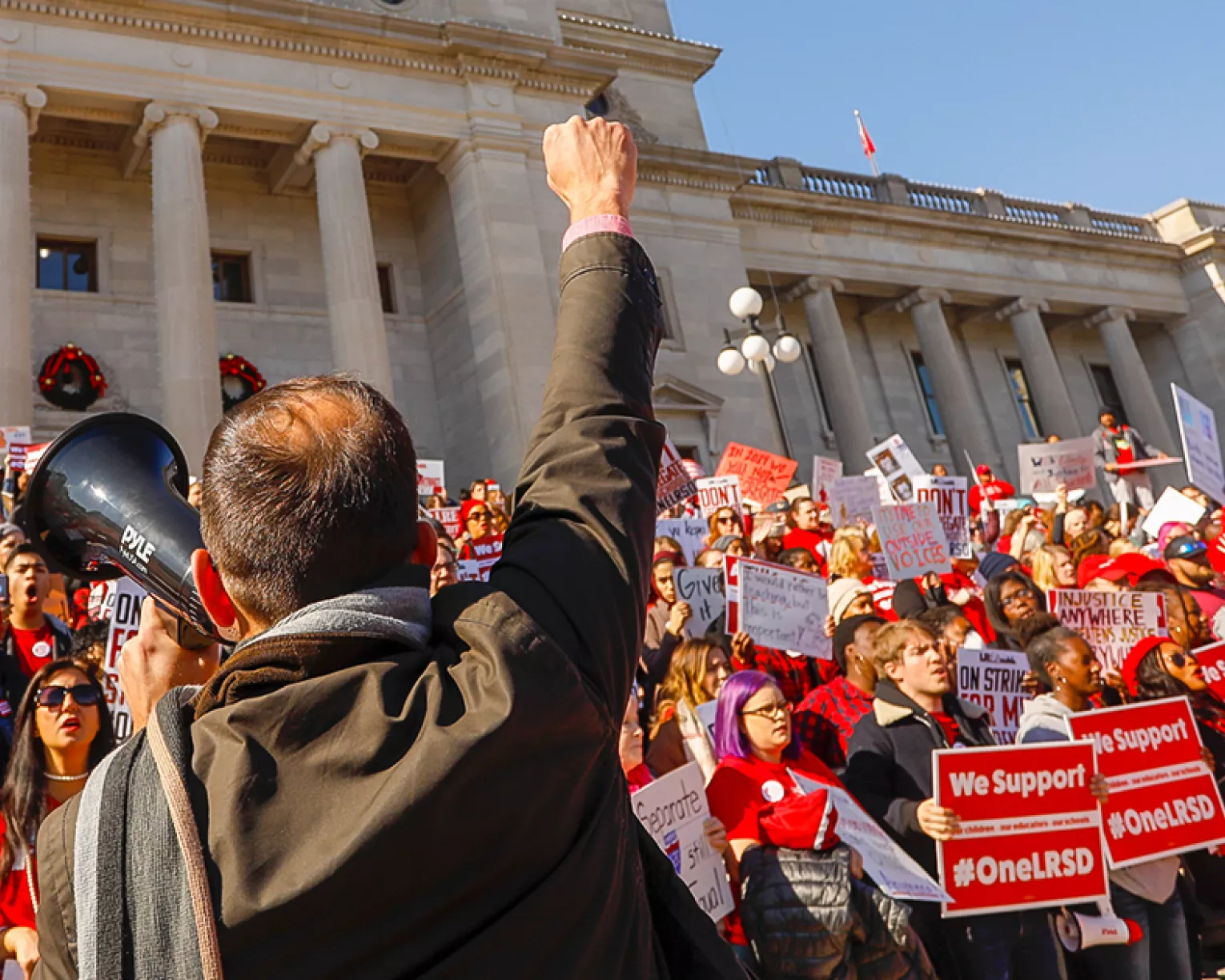Understanding Collective Bargaining

Collective bargaining and advocacy ensure we enhance student learning and improve educator working conditions–benefiting our students, schools, and the community as a whole.
With collective bargaining, educators advocate not only for their working conditions, but also for student learning conditions. We lift our voice for fair compensation and benefits, and also for:
- Smaller class sizes
- Less testing and more time for learning
- Increased staffing of nurses and counselors
- Community schools that meet the needs of students and the community
Get to Know Your Union Contract
How Collective Bargaining Works Benefits of Collective Bargaining

When unions negotiate for teacher working conditions, they also negotiate for the conditions that our children learn in."
Is there collective bargaining in your state?
-
Alabama
K-12 Teachers
LimitedNo bargaining law but limited bargaining takes placeEducation Support Professionals
LimitedNo bargaining law but limited bargaining takes placeHigher Ed Faculty
LimitedNo bargaining law; bargaining takes place by mutual consent -
Alaska
K-12 Teachers
YesBargaining laws covering K-12 teachersEducation Support Professionals
YesBargaining laws covering K-12 and Higher Education ESPsHigher Ed Faculty
MixedBargaining law covering faculty at 4-year institutions but not community colleges -
Arizona
K-12 Teachers
LimitedNo bargaining law but limited bargaining takes placeEducation Support Professionals
LimitedNo bargaining law but limited bargaining takes placeHigher Ed Faculty
LimitedNo bargaining law; bargaining takes place by mutual consent -
Arkansas
K-12 Teachers
NoBargaining is prohibitedEducation Support Professionals
NoBargaining is prohibitedHigher Ed Faculty
NoBargaining is prohibited -
California
K-12 Teachers
YesBargaining laws covering K-12 teachersEducation Support Professionals
YesBargaining laws covering K-12 and Higher Education ESPsHigher Ed Faculty
YesBargaining laws covering faculty at 4-year public education institutions and community colleges -
Colorado
K-12 Teachers
LimitedNo bargaining law but limited bargaining takes placeEducation Support Professionals
LimitedNo bargaining law but limited bargaining takes placeHigher Ed Faculty
LimitedNo bargaining law; bargaining takes place by mutual consent -
Connecticut
K-12 Teachers
YesBargaining laws covering K-12 teachersEducation Support Professionals
YesBargaining laws covering K-12 and Higher Education ESPsHigher Ed Faculty
YesBargaining laws covering faculty at 4-year public education institutions and community colleges -
Delaware
K-12 Teachers
YesBargaining laws covering K-12 teachersEducation Support Professionals
YesBargaining laws covering K-12 and Higher Education ESPsHigher Ed Faculty
YesBargaining laws covering faculty at 4-year public education institutions and community colleges -
Florida
K-12 Teachers
YesBargaining laws covering K-12 teachersEducation Support Professionals
YesBargaining laws covering K-12 and Higher Education ESPsHigher Ed Faculty
YesBargaining laws covering faculty at 4-year public education institutions and community colleges -
Georgia
K-12 Teachers
NoBargaining is prohibitedEducation Support Professionals
NoBargaining is prohibitedHigher Ed Faculty
NoBargaining is prohibited -
Hawaii
K-12 Teachers
YesBargaining laws covering K-12 teachersEducation Support Professionals
YesBargaining laws covering K-12 and Higher Education ESPsHigher Ed Faculty
YesBargaining laws covering faculty at 4-year public education institutions and community colleges -
Idaho
K-12 Teachers
YesBargaining laws covering K-12 teachersEducation Support Professionals
Higher Ed Faculty
LimitedNo bargaining law; bargaining takes place by mutual consent -
Illinois
K-12 Teachers
YesBargaining laws covering K-12 teachersEducation Support Professionals
YesBargaining laws covering K-12 and Higher Education ESPsHigher Ed Faculty
YesBargaining laws covering faculty at 4-year public education institutions and community colleges -
Indiana
K-12 Teachers
YesBargaining laws covering K-12 teachersEducation Support Professionals
LimitedNo bargaining law but limited bargaining takes placeHigher Ed Faculty
LimitedNo bargaining law; bargaining takes place by mutual consent -
Iowa
K-12 Teachers
YesBargaining laws covering K-12 teachersEducation Support Professionals
YesBargaining laws covering K-12 and Higher Education ESPsHigher Ed Faculty
YesBargaining laws covering faculty at 4-year public education institutions and community colleges -
Kansas
K-12 Teachers
YesBargaining laws covering K-12 teachersEducation Support Professionals
YesBargaining laws covering K-12 and Higher Education ESPsHigher Ed Faculty
YesBargaining laws covering faculty at 4-year public education institutions and community colleges -
Kentucky
K-12 Teachers
LimitedNo bargaining law but limited bargaining takes placeEducation Support Professionals
LimitedNo bargaining law but limited bargaining takes placeHigher Ed Faculty
LimitedNo bargaining law; bargaining takes place by mutual consent -
Louisiana
K-12 Teachers
LimitedNo bargaining law but limited bargaining takes placeEducation Support Professionals
LimitedNo bargaining law but limited bargaining takes placeHigher Ed Faculty
LimitedNo bargaining law; bargaining takes place by mutual consent -
Maine
K-12 Teachers
YesBargaining laws covering K-12 teachersEducation Support Professionals
YesBargaining laws covering K-12 and Higher Education ESPsHigher Ed Faculty
YesBargaining laws covering faculty at 4-year public education institutions and community colleges -
Maryland
K-12 Teachers
YesBargaining laws covering K-12 teachersEducation Support Professionals
YesBargaining laws covering K-12 and Higher Education ESPsHigher Ed Faculty
MixedBargaining law covering certain higher education institutions within the state -
Massachusetts
K-12 Teachers
YesBargaining laws covering K-12 teachersEducation Support Professionals
YesBargaining laws covering K-12 and Higher Education ESPsHigher Ed Faculty
YesBargaining laws covering faculty at 4-year public education institutions and community colleges -
Michigan
K-12 Teachers
YesBargaining laws covering K-12 teachersEducation Support Professionals
YesBargaining laws covering K-12 and Higher Education ESPsHigher Ed Faculty
YesBargaining laws covering faculty at 4-year public education institutions and community colleges -
Minnesota
K-12 Teachers
YesBargaining laws covering K-12 teachersEducation Support Professionals
YesBargaining laws covering K-12 and Higher Education ESPsHigher Ed Faculty
YesBargaining laws covering faculty at 4-year public education institutions and community colleges -
Mississippi
K-12 Teachers
NoBargaining is prohibitedEducation Support Professionals
NoBargaining is prohibitedHigher Ed Faculty
NoBargaining is prohibited -
Missouri
K-12 Teachers
YesBargaining laws covering K-12 teachersEducation Support Professionals
YesBargaining laws covering K-12 and Higher Education ESPsHigher Ed Faculty
LimitedNo bargaining law; bargaining takes place by mutual consent -
Montana
K-12 Teachers
YesBargaining laws covering K-12 teachersEducation Support Professionals
YesBargaining laws covering K-12 and Higher Education ESPsHigher Ed Faculty
YesBargaining laws covering faculty at 4-year public education institutions and community colleges -
Nebraska
K-12 Teachers
YesBargaining laws covering K-12 teachersEducation Support Professionals
YesBargaining laws covering K-12 and Higher Education ESPsHigher Ed Faculty
YesBargaining laws covering faculty at 4-year public education institutions and community colleges -
Nevada
K-12 Teachers
YesBargaining laws covering K-12 teachersEducation Support Professionals
YesBargaining laws covering K-12 and Higher Education ESPsHigher Ed Faculty
YesBargaining laws covering faculty at 4-year public education institutions and community colleges -
New Hampshire
K-12 Teachers
YesBargaining laws covering K-12 teachersEducation Support Professionals
YesBargaining laws covering K-12 and Higher Education ESPsHigher Ed Faculty
YesBargaining laws covering faculty at 4-year public education institutions and community colleges -
New Jersey
K-12 Teachers
YesBargaining laws covering K-12 teachersEducation Support Professionals
YesBargaining laws covering K-12 and Higher Education ESPsHigher Ed Faculty
YesBargaining laws covering faculty at 4-year public education institutions and community colleges -
New Mexico
K-12 Teachers
YesBargaining laws covering K-12 teachersEducation Support Professionals
YesBargaining laws covering K-12 and Higher Education ESPsHigher Ed Faculty
YesBargaining laws covering faculty at 4-year public education institutions and community colleges -
New York
K-12 Teachers
YesBargaining laws covering K-12 teachersEducation Support Professionals
YesBargaining laws covering K-12 and Higher Education ESPsHigher Ed Faculty
YesBargaining laws covering faculty at 4-year public education institutions and community colleges -
North Carolina
K-12 Teachers
NoBargaining is prohibitedEducation Support Professionals
NoBargaining is prohibitedHigher Ed Faculty
NoBargaining is prohibited -
North Dakota
K-12 Teachers
YesBargaining laws covering K-12 teachersEducation Support Professionals
LimitedNo bargaining law but limited bargaining takes placeHigher Ed Faculty
LimitedNo bargaining law; bargaining takes place by mutual consent -
Ohio
K-12 Teachers
YesBargaining laws covering K-12 teachersEducation Support Professionals
YesBargaining laws covering K-12 and Higher Education ESPsHigher Ed Faculty
YesBargaining laws covering faculty at 4-year public education institutions and community colleges -
Oklahoma
K-12 Teachers
YesBargaining laws covering K-12 teachersEducation Support Professionals
YesBargaining laws covering K-12 and Higher Education ESPsHigher Ed Faculty
LimitedNo bargaining law; bargaining takes place by mutual consent -
Oregon
K-12 Teachers
YesBargaining laws covering K-12 teachersEducation Support Professionals
YesBargaining laws covering K-12 and Higher Education ESPsHigher Ed Faculty
YesBargaining laws covering faculty at 4-year public education institutions and community colleges -
Pennsylvania
K-12 Teachers
YesBargaining laws covering K-12 teachersEducation Support Professionals
YesBargaining laws covering K-12 and Higher Education ESPsHigher Ed Faculty
YesBargaining laws covering faculty at 4-year public education institutions and community colleges -
Rhode Island
K-12 Teachers
YesBargaining laws covering K-12 teachersEducation Support Professionals
YesBargaining laws covering K-12 and Higher Education ESPsHigher Ed Faculty
YesBargaining laws covering faculty at 4-year public education institutions and community colleges -
South Carolina
K-12 Teachers
NoAlthough bargaining is not statutorily prohibited, the state Supreme Court ruled that public employees do not have the right to bargain.Bargaining is prohibitedEducation Support Professionals
NoAlthough bargaining is not statutorily prohibited, the state Supreme Court ruled that public employees do not have the right to bargain.Bargaining is prohibitedHigher Ed Faculty
NoBargaining is prohibited -
South Dakota
K-12 Teachers
YesBargaining laws covering K-12 teachersEducation Support Professionals
YesBargaining laws covering K-12 and Higher Education ESPsHigher Ed Faculty
NoBargaining is prohibited -
Tennessee
K-12 Teachers
LimitedCollaborative conferencing permittedEducation Support Professionals
NoBargaining is prohibitedHigher Ed Faculty
LimitedNo bargaining law; bargaining takes place by mutual consent -
Texas
K-12 Teachers
NoBargaining is prohibitedEducation Support Professionals
NoBargaining is prohibitedHigher Ed Faculty
NoBargaining is prohibited -
Utah
K-12 Teachers
LimitedNo bargaining law but limited bargaining takes placeEducation Support Professionals
LimitedNo bargaining law but limited bargaining takes placeHigher Ed Faculty
LimitedNo bargaining law; bargaining takes place by mutual consent -
Vermont
K-12 Teachers
YesBargaining laws covering K-12 teachersEducation Support Professionals
YesBargaining laws covering K-12 and Higher Education ESPsHigher Ed Faculty
YesBargaining laws covering faculty at 4-year public education institutions and community colleges -
Virginia
K-12 Teachers
LimitedNo bargaining law but limited bargaining takes placeEducation Support Professionals
LimitedNo bargaining law but limited bargaining takes placeHigher Ed Faculty
NoBargaining is prohibited -
Washington
K-12 Teachers
YesBargaining laws covering K-12 teachersEducation Support Professionals
YesBargaining laws covering K-12 and Higher Education ESPsHigher Ed Faculty
YesBargaining laws covering faculty at 4-year public education institutions and community colleges - Washington, D.C.
-
West Virginia
K-12 Teachers
LimitedNo bargaining law but limited bargaining takes placeEducation Support Professionals
LimitedNo bargaining law but limited bargaining takes placeHigher Ed Faculty
LimitedNo bargaining law; bargaining takes place by mutual consent -
Wisconsin
K-12 Teachers
YesBargaining laws covering K-12 teachersEducation Support Professionals
YesBargaining laws covering K-12 and Higher Education ESPsHigher Ed Faculty
MixedBargaining law covering community college faculty but not faculty at 4-year institutions -
Wyoming
K-12 Teachers
LimitedNo bargaining law but limited bargaining takes placeEducation Support Professionals
LimitedNo bargaining law but limited bargaining takes placeHigher Ed Faculty
LimitedNo bargaining law; bargaining takes place by mutual consent
Your Voice in Non-Bargaining States
Even if bargaining is not permitted in your state, NEA locals can still leverage political and community power, using Bargaining for the Common Good and other advocacy principles to gain greater control over their workplace.
Affiliates use the collective power of their members to win on issues such as increased pay, improved benefits, stronger salary schedules, and better working conditions.
We fight from city halls to state legislatures for increased funding for schools and higher education and for improving student learning outcomes.
Together, members organize to enhance educator input into workplace decisions and to elect pro-public education candidates at the local, state, and national levels.

Collective bargaining is good public policy.
The Benefits of Bargaining
#1. Improved student learning and teacher working conditions.
Educators’ working conditions are students’ learning conditions. By addressing school and classroom issues, everyone wins.
In negotiations, educators and their employers collaborate on student-centered issues such as setting limits on class size, identifying time for teachers and paraeducators to share effective classroom practices, addressing school health and safety issues, and ensuring teacher input into their own professional learning—all of which help students thrive.
#2. Attract and retain the highest quality employees.
Although the educator shortage was an issue before the pandemic, many school districts are experiencing severe shortages as never before.
Experts like the Learning Policy Institute and the Economic Policy Institute note that low pay, poor working conditions, and lack of support for new teachers all play a role in exacerbating the educator shortage.
NEA affiliates, working with school districts and harnessing their members’ input, win for higher pay and improved and safe working conditions, as well as strong mentoring and induction programs for their members.
#3. Advance social justice and racial equity.
NEA affiliates' bargaining has evolved in recent years to have a stronger community focus. Many NEA locals and their employers have opened the negotiation process to include community partners and parents, who develop proposals together to gain critical resources for students and schools.
In many communities, educators, parents, and community allies have come together with the realization that unless they unite to address systemic racism head on, we can never live up to our belief that every student deserves to succeed no matter where they live or how much money their families have.

